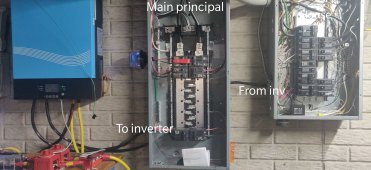Hi thanhrodke: I read this thread with great interest as I received the 6000EX last week and have not been able to commission it to run my Tesla universal mobile charger nor my Juicebox EV charger. Hopefully you'll see my post, since it's been a while. I've posted my issues on another thread, but am re-posting it here since you're successfully charging your Tesla.Copy/paste from my profile:
2 - EG4 6000EX-48HV 120/240V inverters (https://signaturesolar.com/eg4-6k-off-grid-inverter-6000ex-48hv)
6 - EG4 LifePower4 lithium batteries (https://signaturesolar.com/eg4-lifepower4-lithium-battery-48v-100ah)
32 - Solarever 410W Half-Cell Mono PERC solar panels (https://signaturesolar.com/solarever-410w-half-cell-mono-perc-solar-panel-black-full-pallet-31)
So that's about 14.5kW worth of panels. I've seen solar production as high as about 12,000 watts, but as you can see in the pictures, my panels are laid virtually flat on the ground and we are already six weeks past the summer solstice.
I haven't run it long enough to know the exact numbers, but 30kWh won't even come close to charging the tesla in a single go, but that's mostly due to my driving patterns. I have a 140 mile round trip work commute twice a week (work from home the other three days). My 2020 model 3 long range has a 75kWh IIRC, and it takes right about 60% of the battery to do that 140 mile round trip, of which about 80% of it is at 80mph here in texas. That's a raw 45kWh to put back into the battery not counting the inverter conversion losses, the tesla onboard charger losses, nor the battery chemistry losses.
So I've used purely the batteries right when I come home and it's nearly dark, or already dark. I can get about 45-50% of the required recharge put back in, then the following day, I finish the charging with solar.
My setup:
1 - EG4 6000EX
3 - EG4 LifePower4 batteries




